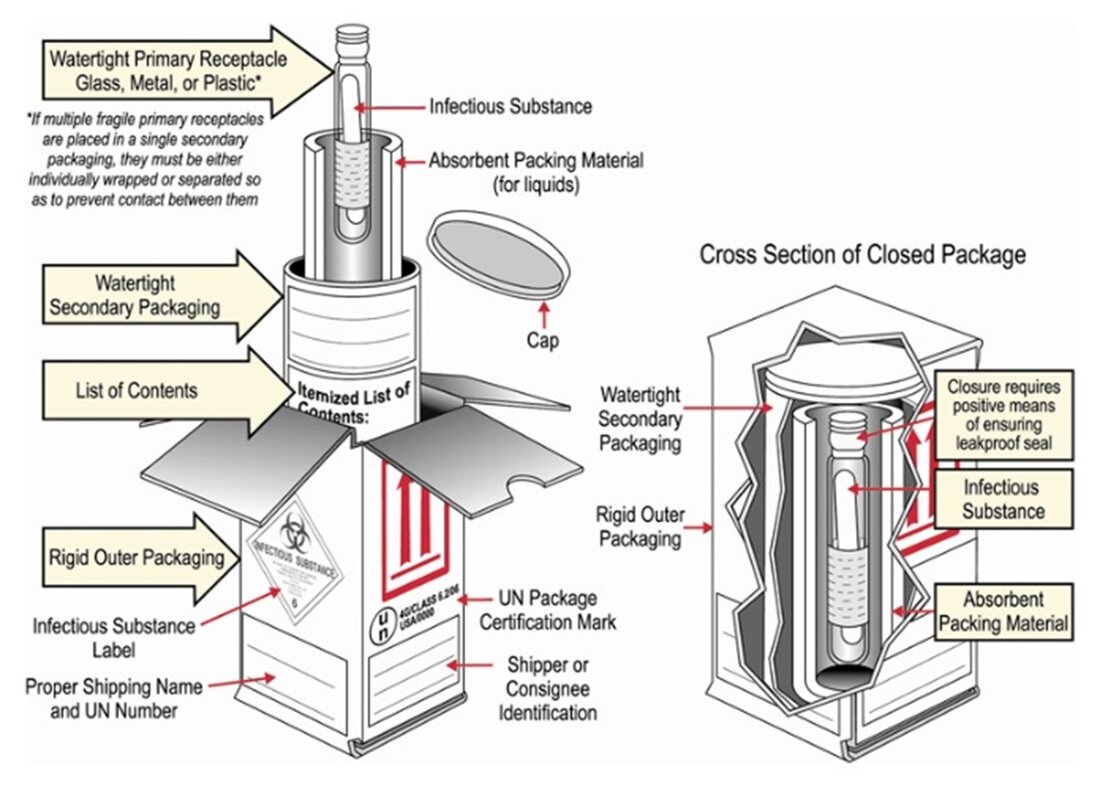Differences Between UN 2814, UN 2900 and UN 3373
August 3, 2023
Understanding the Difference Between UN 2814/UN 2900 (Category A) and UN 3373 (Category B) Shipments
Written By: Debbie Jung
Domestic or international shipping of hazardous materials comes with a great need for understanding the different classifications and regulations to ensure optimal safety for everyone involved. The two common categories that are regularly brought up in biological substance shipping are UN 2814/UN 2900 (Category A) and UN 3373 (Category B). These two classifications have precise instructions for shipping infectious substances and diagnostic specimens. Specific shipping and packaging requirements, regulations, and guidelines are associated with each category. .
The International Air Transport Association, known as IATA, has a Dangerous Goods Regulations (DGR) manual that serves as a global reference for shipping dangerous goods, including Category A & B shipments. This manual is the only standard recognized by the airlines.
Everyone packing or shipping infectious materials must undergo training and certification every two years to comply with the Department of Transportation or IATA regulations. Proper handling of hazardous materials is taken seriously and must be followed for safe transportation*.
Category A – UN2814 and UN2900
Category A is a classification that refers to the transportation of infectious substances capable of causing severe harm to humans or animals when exposure occurs. These substances are known to contain pathogens, such as bacteria, viruses, or other microorganisms, which can cause severe illnesses or even death. Category A Shipping is divided into two categories, UN2814 and UN2900.
Infectious substances that can cause disease in humans or both humans and animals are assigned to UN2814. For UN2900, infectious substances can cause disease in animals. UN2814 substances pose a high risk and require strict adherence to packaging, labeling, and documentation regulations.
The proper shipping name for UN2814 is Infectious substance, infecting humans.
The correct shipping name for UN2900 is Infectious substance, affecting animals only.
Packaging and Labeling Requirements for Category A
Specific packaging requirements for UN2814/UN2900 (Category A) shipments may include using leak-proof primary receptacles, placing them in secondary leak-proof packaging, then enclosing them in the rigid outer packaging. Labeling is placed on the outer packaging with infectious substance (diamond-shaped label), proper shipping name and UN 2814 certification mark, shipper and consignee identification (name, address, and telephone), and package orientation arrows. This labeling and packaging are mandatory for the transportation of these materials safely.
 Figure 1: Packaging Requirements for Category A Substances (source: cdc.gov)
Figure 1: Packaging Requirements for Category A Substances (source: cdc.gov)
Category B – UN3373
Unlike Category A, Category B UN3373 refers to transporting diagnostic specimens, including human or animal samples, for clinical testing, research, or disease diagnosis. Category B UN3373 does not contain material that causes human and animal diseases. But, they can still contain microorganisms or other hazardous materials that can be harmful if not handled properly. While Category B UN3733 doesn't pose the same risk level as Category A shipments, it is still mandatory to follow careful handling, labeling, and compliance with specific shipping requirements.
The proper shipping name for UN 3733 is Biological Substance, Category B.
Packaging and Labeling for Category B
The packaging requirements for Category B are like Category A in that it requires using a leak-proof primary container, placing them in a secondary leak-proof packaging, and enclosing them in the rigid outer packaging. Labeling is, again, placed on the outer packaging with the proper shipping name and UN 3373 certification mark, shipper and consignee identification (name, address, and telephone), and package orientation arrows.
Transporting diagnostic specimens requires clear and careful compliance with UN regulations.
 Figure 2: Packaging Requirements for Category B Substances (source: cdc.gov)
Figure 2: Packaging Requirements for Category B Substances (source: cdc.gov)
Shipping Documentation
Documentation is a mandatory and crucial step for successful hazardous materials shipping. You must complete an Airway Bill or Bill of Landing. The Airway Bill will contain the name, address, and telephone number of the person responsible for the package. You must indicate if your package has dry ice using the proper labeling mentioned above for both Category B and Category A shipping. If so, write Dry Ice, Class 9, UN1845, __ kg, and the number and quantity of dry ice per package.
Conclusion
The difference between Category A and Category B shipments is crucial for anyone involved in shipping infectious or hazardous materials. Following the proper packaging, labeling, and documentation is mandatory. As some penalties and fees may follow with sending such material, it is important to advise a shipping expert. At Mercury, we provide this expertise and guidance to our clients so our clients can focus on the vital work of research. Shipping isn't everyone's expertise for a reason, and we understand that. For help with your biological shipment, reach out to Mercury, where we can work with you 1:1 to successfully ship your Category A or Category B shipment.
https://www.cdc.gov/smallpox/hcp/laboratories/specimen-packing.html *